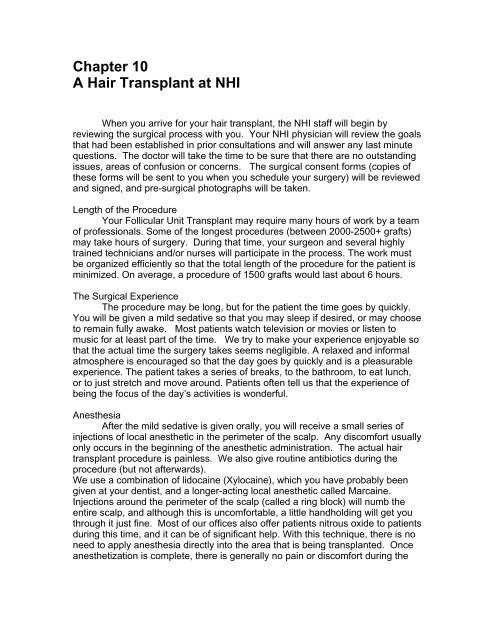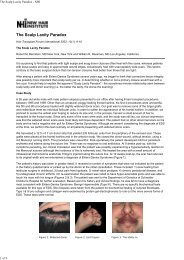The Patient's Guide to Hair Restoration - New Hair Institute
The Patient's Guide to Hair Restoration - New Hair Institute
The Patient's Guide to Hair Restoration - New Hair Institute
You also want an ePaper? Increase the reach of your titles
YUMPU automatically turns print PDFs into web optimized ePapers that Google loves.
Chapter 10<br />
A <strong>Hair</strong> Transplant at NHI<br />
When you arrive for your hair transplant, the NHI staff will begin by<br />
reviewing the surgical process with you. Your NHI physician will review the goals<br />
that had been established in prior consultations and will answer any last minute<br />
questions. <strong>The</strong> doc<strong>to</strong>r will take the time <strong>to</strong> be sure that there are no outstanding<br />
issues, areas of confusion or concerns. <strong>The</strong> surgical consent forms (copies of<br />
these forms will be sent <strong>to</strong> you when you schedule your surgery) will be reviewed<br />
and signed, and pre-surgical pho<strong>to</strong>graphs will be taken.<br />
Length of the Procedure<br />
Your Follicular Unit Transplant may require many hours of work by a team<br />
of professionals. Some of the longest procedures (between 2000-2500+ grafts)<br />
may take hours of surgery. During that time, your surgeon and several highly<br />
trained technicians and/or nurses will participate in the process. <strong>The</strong> work must<br />
be organized efficiently so that the <strong>to</strong>tal length of the procedure for the patient is<br />
minimized. On average, a procedure of 1500 grafts would last about 6 hours.<br />
<strong>The</strong> Surgical Experience<br />
<strong>The</strong> procedure may be long, but for the patient the time goes by quickly.<br />
You will be given a mild sedative so that you may sleep if desired, or may choose<br />
<strong>to</strong> remain fully awake. Most patients watch television or movies or listen <strong>to</strong><br />
music for at least part of the time. We try <strong>to</strong> make your experience enjoyable so<br />
that the actual time the surgery takes seems negligible. A relaxed and informal<br />
atmosphere is encouraged so that the day goes by quickly and is a pleasurable<br />
experience. <strong>The</strong> patient takes a series of breaks, <strong>to</strong> the bathroom, <strong>to</strong> eat lunch,<br />
or <strong>to</strong> just stretch and move around. Patients often tell us that the experience of<br />
being the focus of the day’s activities is wonderful.<br />
Anesthesia<br />
After the mild sedative is given orally, you will receive a small series of<br />
injections of local anesthetic in the perimeter of the scalp. Any discomfort usually<br />
only occurs in the beginning of the anesthetic administration. <strong>The</strong> actual hair<br />
transplant procedure is painless. We also give routine antibiotics during the<br />
procedure (but not afterwards).<br />
We use a combination of lidocaine (Xylocaine), which you have probably been<br />
given at your dentist, and a longer-acting local anesthetic called Marcaine.<br />
Injections around the perimeter of the scalp (called a ring block) will numb the<br />
entire scalp, and although this is uncomfortable, a little handholding will get you<br />
through it just fine. Most of our offices also offer patients nitrous oxide <strong>to</strong> patients<br />
during this time, and it can be of significant help. With this technique, there is no<br />
need <strong>to</strong> apply anesthesia directly in<strong>to</strong> the area that is being transplanted. Once<br />
anesthetization is complete, there is generally no pain or discomfort during the



